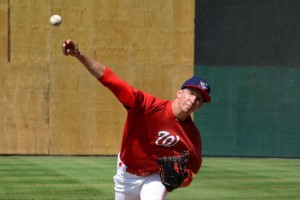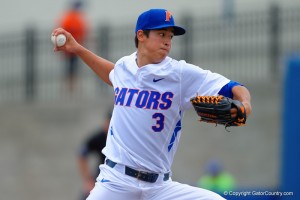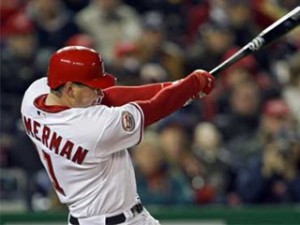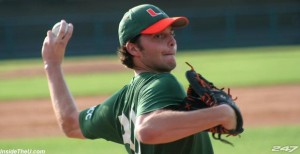Third in our set of Draft class Reviews for the 2016 season. First was the 2016 class, then the 2015 class.
Web links to use while reading:
- Stats are pulled from milb.com and/or fangraphs.com; put the player name into the search bar to get his seasonal stats
- The MLB.com Draft Tracker (which I believe is the best draft tracker out there) is the best place to get draft class information.
- The Big Board and the Draft Tracker are the goto resources for prospects for any Nats fan.
- More obscure stats on players are sometimes found at places like thebaseballcube.com, perfectgame.org, their college websites, twitter accounts for the players, and good old fashioned deep-dive googling.
- My historical list of Nats prospect rankings, updated for all 2016 mid-season rankings.
With out further ado…
Round 1: Erick Fedde RHP (starter) COL jr from UNLV. 8-5 with a 3.12 ERA in 23 games (22 starts) across 2 levels. 123/29 K/BB in 121 IP. 1.21 combined whip, 3.22 fip and .316 babip in Potomac. Fedde began the year in the Potomac rotation and struggled in his first 6-7 starts. Then something clicked; from late May through his eventual promotion to AA in early august, he threw 10 straight starts giving up 0 or 1 earned runs, driving his ERA down from somewhere in the 6.60 range in May to a sub 3.00 ERA for the year in High-A. His final Potomac start may have been his best: 10 strikeouts, 5 hits and 1 unearned run in 7 innings. In his limited time in AA, he had one blow-out but was other wise also solid (in his last start of the season he had 12 strikeouts in 6 innings). Fedde looks completely back to his first round projection form and may quickly add his name to the list of guys in AAA pushing for a promotion to the majors. Trending up.
Round 2: Andrew Suarez LHP (starter) COL jr from Miami (FL). Did not sign: 2nd round signee for San Francisco in 2015. Spent most of 2016 starting for SF’s AA team in Richmond and looked solid. He may need another year in AA.
Round 3: Jakson Reetz, C Norris HS (NE). Slashed .230/.346/.357 splitting time at C in Hagerstown. 79/38 K/BB, 4homers, 4SBs. Reetz’ first foray into full-season ball did not result in appreciably better results all around at the plate. He improve his slugging percentage with more XBH, but his average remains poor. 79 Ks in 283 ABs is a hefty percentage. This was his age 20 season, playing in Low-A, and there’s not a ton of competition for the High-A catcher job next year, so he likely moves on up, but i’m a bit down on him at this point. Perhaps unfairly. Truth is, he got a big bonus and the team will give him plenty of room to grow. Trending down.
Round 4: Robbie Dickey, RHP (reliever) from Blinn College (TX). 2-0, 3.48 ERA for two levels relieving. 26/18 K/BB in 20 2/3rds innings. 1.89 whip, 5.60 fip, .345 babip while in Hagerstown. Dickey started the season in Short-A, his third successive year in Auburn. This time though he forced his way up, featuring as a reliever now instead of a starter, giving up 1 hit in 8 innings and quickly getting pushed up to Hagerstown. Once there, he quickly got hurt and when he returned his control left him; he walked 15 but struck out 15 in 12 2/3 low-A innings. He now has 46 walks in 78 professional innings and we may begin wondering when he’s going to put things together. 2017 is a make-or-break season for Dickey; he’s going to be (believe it or not) rule-5 eligible after next season and he’s yet to come close to mastering Low-A. I’m guessing he’s in the Hagerstown bullpen and as an upper round pick will be given a few more chances before the team cuts bait. Trending down.
Round 5: Drew Van Orden RHP (starter) COL sr from Duke. Released 3/16/16. Now this kind of surprised me. No he wasn’t a dominant swing and miss guy in 2015 (47 Ks in 92 IP) but he gave the team a bunch of innings at a 3.61 ERA clip. I guess he’s a victim of the pitcher-heavy drafts of this time frame. He’s also a victim of being a low bonus, low investment senior sign.
Round 6: Austen Williams RHP (starter) COL jr from Texas State. Went 5-13 with a 5.45 ERA in 26 starts for High-A and AA. 78/48 K/BB in 140 1/3 innings, 1.74 whip, 5.00 fip and .339 babip while in AA. Williams was in the opening day AA rotation after a stellar 2015 but was demoted back to High-A after two months of AA struggles. Once back in High-A, he couldn’t repeat his 2015 success there and got hit hard. His Potomac ERA was 3 points higher this year than it was last year. His 2015 season put him on the prospect map (around 20th on Nats prospect lists) and his 2016 season has caused his name to vanish. Now what? I guess you start him back in AA again and hope that the 2nd time around is better. Trending down.
Round 7: Dale “D.K.” Carey OF (CF) COL sr from Miami (FL). Slashed .209/.341/.331 while playing all three OF positions for Potomac. 84/63 K/BB ratio in 326 ABs, 7 homers, 5 SBs. A ton of walks jacked up his OBP and helped off set his poor BA in High-A this year. Carey’s problem is that the OF spots are scarce the higher you go. He played along side the best hitting prospect in our system (Victor Robles) and 2015 2nd round pick Andrew Stevenson has already passed him by. He may be victim of a numbers game in 2017, all the more so since he was signed for a relative pittance as a senior. I wouldn’t be surprised to see him get cut loose at the end of spring training 2017. Trending down.
Round 8: Jeff Gardner, LF COL sr from Louisville. Released 6/6/16. As predicted, Gardner failed to make Hagerstown and then failed to prove he could earn an Auburn job and was released once the 2016 signings came in.
Round 9: Austin Byler, 1B COL jr for Nevada (Reno). Did not sign: became an 11th round by Arizona in 2015. He ended 2016 with Arizona’s high-A Visalia team after serving a PED suspension that cost him the first two months of the season.
Round 10: Matthew Page, RF/1B COL sr from Oklahoma Baptist U. Slashed .267/.348/.419 while earning a promotion from Low-A to High-A. 99/53 K/BB in 415 ABs. 11 homers, 3 SBs. Yes that’s a lot of Ks. But Page is turning into a nice little pick up. He had an OPS above .800 and slugged 10 homers in 88 games for Hagerstown before earning a promotion to Potomac. Playing 1B exclusively this year (he was drafted as a RF) he really struggled power-wise once he got to High-A (just 3 XBH in 30 games), but he earned the promotion in the first place. I don’t think there’s anyone to push him off the position to start next year at Potomac … but he’s gotta rebound and show he can hit in High-A like he did in Low-A. Trending Steady.
Round 11: Weston Davis RHP (starter) Manatee HS (FL). Went 3-6 with a 2.67 ERA in 11 starts for Auburn. 33/11 K/BB in 54 IP, 0.93 whip, 3.07 fip, .236 babip. Davis missed all of 2015 after signing out of HS in 2014, was in the Auburn opening day rotation and stayed there the whole season. He turned 20 during the season but more than held his own against the older competition. He looks pretty promising after missing a whole year and barely pitching his draft year. My one nit is his K rate; just 33 in 54 IP. He should be in the Hagerstown rotation to start 2017. Trending Up.
Round 12: Domenick Mancini RHP (reliever) from Miami-Dade CC South. Released 6/27/15.
Round 13: Austin Davidson, 3B COL jr from Pepperdine. Slashed a healthy .272/.377/.443 between Low- and High-A in 2016. 46/49 K/BB ratio in 316 ABs, 9 hrs and 5 SB. Davidson was stranded in XST to start the year then returned to Hagerstown in late April only to play sparingly until June. From there he played pretty consistently both for Hagerstown and then for Potomac (he got promoted in early July for the 2nd Half). He had solid numbers and a great OBP in both land a solid enough slugging even without a ton of homers. He also had more walks than strikeouts, which I believe is the first time I’ve seen that for any hitter profiled in these posts. His problem seems to be positional; he’s listed as a “DH” on Milb.com, was drafted as a 3B but played in the field sparingly this year (some 2B, some 3B). I’d guess he’s pegged for a 2B slot, but then that has him competing with the generic “middle infielder” type who is dotted all over these low-minors rosters. Nonetheless, he’s not going to get cut when he’s one of the few guys posting .800 OPS figures in the system, so i’m trending him up. I figure he’ll do the Potomac to Harrisburg thing in 2017 assuming he continues to be a tough out. Trending up.
Round 14: James Bourque RHP (starter) COL jr from Michigan. 5-6 with a 5.03 ERA in 17 games/13 starts for Hagerstown. 55/23 K/BB in 68ip. 1.53 whip, 4.89 fip, .327 babip. Bourque missed all of 2015 with injury and then hung around XST until early June. From there he featured in the Hagerstown rotation for the most part, but his role seemed to be “spot starter” instead of rotation guy. He didn’t have the best numbers, no two ways around it. Maybe it was rust. I’m guessing he’ll get another shot at the Hagerstown rotation in 2017 but may be a release candidate. Trending Down.
Round 15: Ryan Ripken 1B COL soph from Indian River State (FL). Slashed just .201/.241/.254 between Low-A and Short-A. 73/20 K/BB in 374 ABs, 3HR, 1SB. Ripken started the year in Hagerstown but hit just .190 and got dumped back to Short-A. He’s now got three pro years under his belt and is hitting just .205 for his career, mostly in short-season ball. Its hard to see him continuing to get chances even given his family pedigree. Trending down.
Round 16: Cole Plouck LHP (reliever) from Pima CC (AZ): Released on 6/29/15.
Round 17: Alec Keller CF COL sr from Princeton by way of Richmond VA and Freeman HS. Slashed .285/.338/.374 playing a full season (mostly in LF) for Potomac. 78/35 K/BB, 3homers, 14SB. Keller more or less replicated his High-A numbers posted in the 2nd half of 2015; solid average, not a ton of power. Keller’s issue is that the tryouts for the AA outfield are looking tough; he may be hard pressed to get a promotion in a corner OF spot without any power. I’m guessing he makes AA as a 4th outfielder in 2017. As I noted last year though, he’s performing great for a senior sign from an Ivy league school. Trending Steady.
Round 18: McKenzie Mills, LHP (starter), Sprayberry Senior HS (GA). 4-5, 3.71 ERA in 12 starts for Short-A. 46/28 K/BB in 53 1/3 innings, 1.33 whip, 4.03 fip, .269 babip. Mills was the #2 starter in Auburn to start the season … and was the #2 starter at the end of the season. He posted a solid season; not awe-inspiring but pretty good for a guy who doesn’t turn 21 until next month. He addressed the issues that plagued him in 2015 and his hits/inning figure looks great. I’d like to see how he does in full season ball and project him in the Hagerstown rotation in 2017. Trending Steady.
Round 19: Clay Williamson, OF (RF) COL jr from Cal State Fullerton. Released 6/29/15.
Round 20: Bryan Langlois, RF COL jr from Pepperdine: Apparently retired Jan 2015 (per the Big Board), but he doesn’t have an official transaction listed in MILB.com. He didn’t play for us after 2014 despite not being officially released.
Round 21: Connor Bach, LHP COL sr from Virginia Military Institute by way of Centreville HS in Clifton. Went 0-1 with a 7.30 ERA in 5 relief appearances in Low-A and then was released on 6/1/16. This one was another shocker for me; he was in Hagerstown’s rotation the whole of 2015 and was good; what happened to him in 2016? Miami picked him up 6 days after we released him but he was similarly bad for them and they cut him loose a month later. Such a strange set of circumstances.
Round 22: Daniel Salters, C COL soph from Dallas Baptist: did not sign: drafted by Cleveland in the 13th round of 2015 draft. He was in High-A and AA for Cleveland this year.
Round 23: Chris Riopedre, SS COL jr, East Tennessee State. Released on 6/25/15.
Round 24: Kyle Simmons RHP (reliever) COL jr Texas Lutheran U. Released on 5/3/16 after not appearing in 2015 and failing to make a full season squad in 2016.
Round 25: Kyle Bacak C COL sr from Texas Christian U. Released 1/20/15.
Round 26: Chase McDowell RHP (reliever) COL 5S Rice (TX): Retired 4/9/15
Round 27: Conor Keniry SS COL sr Wake Forest U. Released on 4/2/16 after playing sparingly in 2015 and failing to make either Hagerstown or Potomac as a backup infielder.
Round 28: Kida De La Cruz, RHP (reliever) from Volunteer State CC (TN). Released on 3/26/16 after throwing just 19 innings in two seasons in the GCL.
Round 29: DJ Jauss, RHP COL 5S from U. Mass. Amherst: Released 3/26/15.
Round 30: Tyler Mapes RHP COL sr from Tulane U. (LA). went 12-10 with a 3.19 ERA for AA Harrisburg. 25 games/25 starts. 78/39 K/BB ratio in 155 innings. 1.25 whip, 4.22 fip, .283 babip. Mapes was the #2 starter in Harrisburg all year and continues to be a fantastic draft pickup for this team. Who would have thought a 30th rounder college senior who probably signed for a few thousand dollars would be on the brink of the AAA roster? He doesn’t have the best strikeout numbers, which may define a glass ceiling for him, but he should continue to matriculate to AAA next year. That being said, its crowded at the top, so I wouldn’t be surprised if he’s back in AA. Trending up.
Round 31: Samuel Johns RHP COL 5S U. Evansville (IN). Released 1/12/16. What was surprising about this release was the timing; why not let him compete in spring training for a Hagerstown spot? The January release is an odd one.
The rest of the 2014 draft class was HS kids who were long shots to sign and a Juco kid in the 40th who already had a transfer agreement to a good baseball school; one more piece of evidence to perhaps shorten the draft to 35 or even 30 rounds? Here’s a quick summary.
Round 32: Elliott Cary: CF Clackamas HS (OR): did not sign: honored commitment to Oregon State. Started 24 games as a freshman but did not play in 2016 (injured?).
Round 33: Clay Casey: CF DeSoto Central HS (MS): did not sign: was initially set to attend Ole Miss, but then changed his mind and attended Northwest Mississippi CC to be draft eligible in 2015. He didn’t get drafted though, so he then enrolled at the U. of Houston. Update: things didn’t work out there, so he transferred to D2 Delta State University, where he had a successful 2017 season in what was his “junior” year.
Round 34: Evan Skoug: C Libertyville HS (IL): did not sign: honored commitment to TCU. At TCU he has been a starter since day 1 and was named Freshman All-American. As a sophomore he slashed .301/.390/.502 and was 2nd team all-conference. I’d say its safe to say he has made himself some money in College.
Round 35: Tommy Doyle RHP Flint Hill School in Oakton: did not sign: honored commitment to Virginia. At UVA, Doyle played an integral part in getting UVA out of the regional his freshman year but did little else for the team as UVA surprisingly won the CWS. As a sophomore, he had a 5.07 ERA all told as he was convered from mid-week starter to “closer” towards the end of the season. I’m guessing he’s back in the rotation for his junior year as the Cavaliers are a bit short on starters.
Round 36: John Henry Styles, LHP Episcopal HS (TX): did not sign: honored commitment to Stanford. There, he’s had almost no playing time, getting 5 appearances as a freshman and just one as a sophomore.
Round 37: Quinn Brodey, LHP Loyola HS (CA): did not sign: honored commitment to Stanford. There he was a 2-way player as a freshman but moved to the OF as a sophomore, slashing .280/.302/.445 this year and being named All Pac-12.
Round 38: Stuart Fairchild RF Seattle Prep (WA): did not sign: honored commitment to Wake Forest. As a sophomore this year he started every game and slashed .293/.403/.470.
Round 39: Jon Littell, OF Stillwater HS (OK): did not sign: honored commitment to OK State. As a sophomore this year, he slashed .258/.332/.343.
Round 40: Jacob Hill LHP JUCO Orange Coast Coll. (CA): did not sign: transferred to U San Diego, then was drafted by Cleveland in the 32nd round of 2015 and also did not sign. He went back to San Diego for his senior year, only threw 8 innings in 2016 and was not drafted.
Trending Summary:
- Trending Up (4): Fedde, Davis, Davidson, Mapes
- Trending Steady (3): Page, Keller, Mills
- Trending Down (6): Reetz, Dickey, Williams, Carey, Bourque, Ripken
- Released/Retired (15): Van Orden, Gardner, Mancini, Plouck, Williamson, Langlois, Bach, Riopedre, Simmons, Bacak, McDowell, Keniry, De La Cruz, Jauss, Johns
- Did Not Sign in 2014 (12): Suarez, Byler, Salters, Cary, Casey, Skoug, Doyle, Styles, Brodey, Fairchild, Littell, Hill
Executive Summary
At this point just 7 of the 40 players are trending in what can inarguably be considered a positive fashion; 15 of the 28 players signed have already been cut loose and another 6 of them are heading that way. Is this destined to be a one-player draft? Who else besides Fedde is projecting as a major leaguer?




